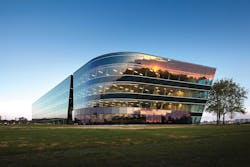As the U.S. economy sputters back to life, contractors wait for the green light on projects [2013 Giants 300 Report]
The narrative of the U.S. nonresidential construction industry of the last 12 months has been one of growth, but in all the wrong places. While five of the 16 major construction sectors grew last year—some significantly—those that experienced the largest gains represent a relatively small portion of the overall market. On the flip side, several sectors that saw the steepest decline last year happen to make up a fairly sizable portion of nonresidential construction.
Lodging, for example, has been on a tear in recent months, growing 16.6% between April 2012 and April 2013 in order to meet the increase in business and leisure travel. Double-digit YOY growth is good news any way you look at it, but the fact that lodging represents just 2% of the overall market means it will do little to move the needle. Same goes for the transportation (11.4% growth), commercial (1.9%), and office (1.6%) sectors: their growth is muted by their relatively small size.
On the other hand, major sectors like education, power, and highway and street all saw a drop in construction spending last year.
“As a result, when you look at the aggregate, we’re not seeing much of a recovery in nonresidential construction spending,” said Anirban Basu, Chief Economist with the Associated Builders and Contractors (ABC) and Chairman and CEO with Sage Policy Group, during his recent mid-year construction forecast.
TOP CONTRACTORS
2012 Total Revenue ($)1 Turner Corporation, The $9,084,870,0002 Fluor $4,268,290,5003 Skanska USA $4,076,092,8144 PCL Construction Enterprises $3,981,419,1645 Whiting-Turner Contracting Co., The $3,699,782,7716 Clark Group $3,563,246,7197 Balfour Beatty $3,453,790,8478 Gilbane $3,083,529,0009 Structure Tone $2,947,433,00010 McCarthy Holdings $2,546,000,000
TOP CONSTRUCTION MANAGEMENT FIRMS
2012 Total Revenue ($)1 URS Corp. $297,282,0762 STV $227,390,0003 JE Dunn Construction $207,304,1544 Barton Malow $182,697,8975 Parsons Brinckerhoff $179,900,0006 S. M. Wilson & Co. $168,859,7407 Turner Corporation, The $157,920,0008 Jones Lang LaSalle $140,020,0009 LPCiminelli $139,198,32910 Structure Tone $132,000,000
“What we’re seeing is a real dichotomy in the market. There is evidence of private-sector improvement in the data, but we also see strong evidence of constrained public-sector budgets affecting major markets like education and public safety,” he says.
Basu predicted a 5-6% bump in total nonresidential construction spending in 2013, with the bulk of the gains coming from the commercial and industrial sectors. “It’s not terrible news, but given how far nonresidential activity had fallen, this is a really slow rebound at best,” he added.
Adding to the frustration of AEC firms, said Basu, is the reluctance of many building owners and developers to pull the trigger on new construction and renovation projects. He said there are enough positive indictors in the U.S. economy to justify greenlighting projects: 2% GDP growth this year, even with the sequestration measures taking hold; falling unemployment numbers; positive consumer spending and household wealth figures; an upturn in housing construction; near-historic-low interest rates; shrinking office and industrial vacancy rates; healthy hotel occupancy rates; and budget surpluses in some states.
“All of this suggests we should be in the midst of a fairly robust nonresidential construction recovery, but it’s simply not taking place,” said Basu, offering some possible explanations: uncertainty related to the Affordable Care Act; an investor community that remains largely skittish; slow population growth; troubled state and local government budgets; public pension concerns; high unemployment rates; European Union budget woes; and the overall rise in healthcare costs.
This mixed bag of positive and negative economic data translates into a gradual recovery for the nonresidential construction market.
